ARCHITECTURAL REVIEW
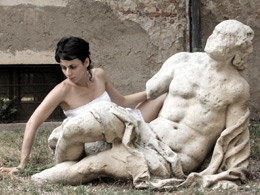
27 November, 2013
Disorientation, orientation nai new relations
How do people move in between the monuments?
Do they react with the past?
How do they relocate themselves in the labyrinths of the medieval town?
If the statues got breath how would they move?
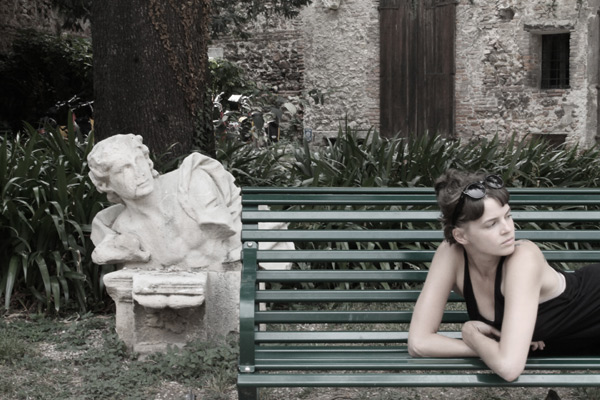
The present project was prepared in the context of the second DAS - "Dance Architecture Spatiality" workshop, organised by the Erasmus program. The participants came from 4 european countries: Greece (Vakalo Art & Design College), UK (University of Derby), France (school of Architecture in Montpellier & Paul-Valery University - Montpellier III and Italy (University IUAV of Venice). It held in Vicenza, Italy last July, while in 2014 will be completed in Monpellier, France.
The main query in this workshop is the relationship between the human body and the architectural space, how each architectural work can be experienced through movement. An additional issue to be considered this year was the vocal-music experience at the same places. Working for fifteen days under the guidance of choreographer Patrice Barthès and musicologist Els Janssens-Vanmunster in practical terms and under the supervision of the teachers in the theoretical part, the students held a public performance in the city's central street (corso Palladio) and presented individual or group projects to the team.
Andrea Palladio's significant work in Vicenza triggered off a sequence of stimulations provided by the coordinators of the workshop: "Oedipus Rex" by Sophocles that was the first work staged in the Teatro Olimpico[1] in 1585, Henry Bauchau's novel "Oedipus sur la route» based on the myth of Oedipus and "Don Giovanni"[2] film directed by Joseph Losey, many scenes of which take place in Palladian villas in the suburban area of Vicenza, are some of the tools that were used not only for the final performance but for students' projects as well.
There are 23 buildings of Andrea Palladio around Vicenza (N. Italy, region of Veneto) and this is an additional reason why the city is included in UNESCO World Heritage list. The urban planning of the historic center is typical medieval: it is surrounded by a wall with open spaces where churches and other public buildings lie. From and towards these squares, many narrow streets compose an irregular planning, full of dead ends and zigzags. This planning was devised in order to confuse the enemies.
Palladio (1508-1580) lived in the years of Mannerism, a crucial period for the Renaissance ideals, when sophisticated, complex and distorted compositions both in architecture and the fine arts dominated over the perfect proportions, realistic representation, simple geometric forms etc. Moreover, due to the recession of those years, the upper classes switched the commercial with agricultural activity thus, the need to build villas in the countryside of the region was created. Palladio designed many of these villas (Rotonda, Cornaro, Emo etc.) as well as public buildings in the town centers. Throughout his work it is clear that he had been influenced by the ancient Greek and Roman architecture and he was the first architect who concerned about the relationship of the building with the landscape in terms of continuation.
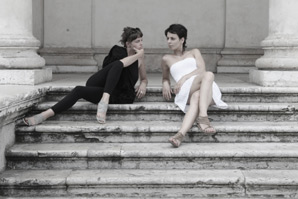
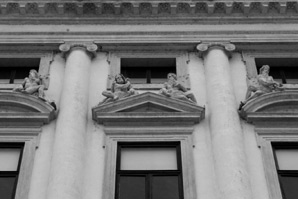
With this study we are trying to explore the relation between the significant architectural monuments of Vicenza and the present. It's an effort to combine the echoes of the past with the sounds of the contemporary living. The whole project is based on the stillness of the statues overlooking the city as well as at the feeling of disorientation.
The statues in their manneristic poses look as if they are watching constantly throughout the centuries any action taken place below. They are present from the late Renaissance to our days and it seems that even whilst are able to adapt themselves to the modern way of living. We could certainly imagine their next movement.
The word "disorientation" refers to several points of this particular workshop. The zigzag streets as well as the dead ends in the medieval town center provoke such feelings and force visitors to an ongoing planning of their courses. Moreover, the young and charming nobleman Don Giovanni of the film seduces women leaving them desperate and alone afterwards to re-orientate themselves in their lives. From the other hand, Oedipus is another hero-victim of disorientation: he goes blind to punish himself as soon as he finds out the truth about his life. He tries thenceforth to orient himself by his senses however many times he needs to be guided by the people surrounding him. Last but not least, mannerism itself encourages the artificiality and the pretentiousness in both architecture and arts, aiming mainly to shift the attention from the important to meaningless, from the foreground to background. Palladio is the first to have the architecture re-orientated towards classicism.
Based on the above, we began studying the way the statues stand by reproducing our bodies to this stillness. We also made some videos with people passing by and through the historical buildings trying to explore the new relations in between them. We end up with a performance in a place between a medieval building and the Basilica, which due to its irregular geometry gives different perspectives towards the town and creates interesting qualities of sounds. Moreover, its asymmetrical plan contrasts against the symmetry of Basilica. We used threads to "translate" into 3 dimensions the complex map of the historical center and to connect the Basilica to the opposite medieval building where a modern café lies. As regards the music of the video, there is no intention to support the action with any song but to accompany the image with a dynamic element, an autonomous synthetic tool. The parallel streaming of video and audio as two seemingly disparate components, gives another dimension both in music and performance. This is the musical composition «Sonne», of the Rammstein band. The lyrics refer to the property of the sun not only to illuminate and guide but to blind as well.
The choreography begins with the awakening of two statues by the presence of a woman. They are moving slowly while the woman is moving to the rhythm of contemporary life. Once they gain awareness of their human existence, their movements become smoother while the woman's motions become less tense. A new relation is now created and eventually an interplay of movements between them.
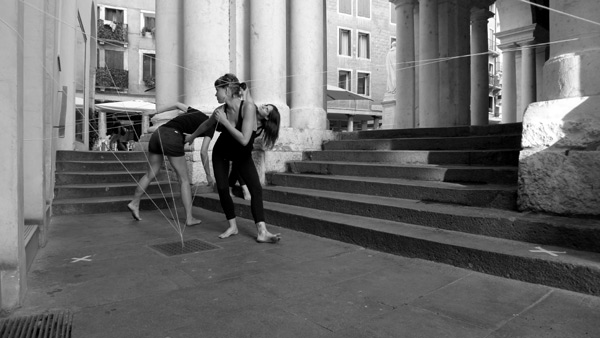
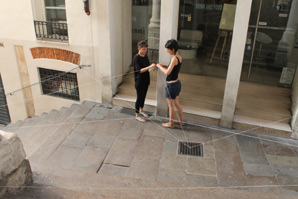
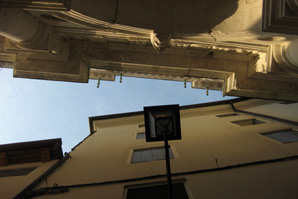
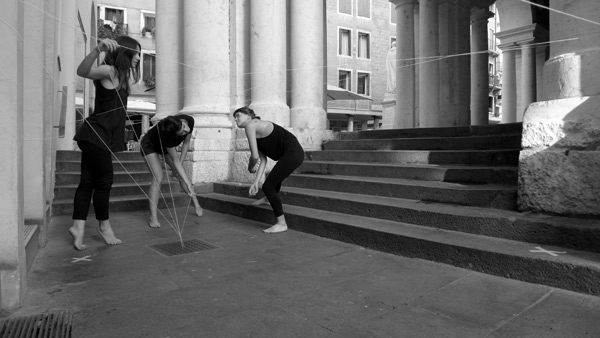
A project by Gaia Ceresi (IUAV), Nikki Dretaki (Vakalo), Eirini Cacari (Vakalo)
For the DAS|Dance,Architecture,Spatiality Workshop
Supervisors | Manolis Iliakis (Vakalo), Monique Arnaud (IUAV)
[1] Teatro Olimpico was designed by A.Palladio in 1579. The architect proposed a fixed wooden scenery in the standards of the Roman theaters. The stage structure was completed under Vicenzo Scamozzi's supervision due to the death of the former. The scene depicts the streets of Thebes, the city of Oedipus.
[2] This is a film based on the famous opera "Don Giovanni" with music by Mozart and text (libretto) by Lorenzo Da Ponte. The plot, narrated in a comic-dramatic way (drama giocoso), is inspired by the legends of Don Juan, an immoral nobleman who seduces women of every social class.
Related articles:
- Now or Never 2012 ( 23 February, 2013 )
- Workshop DAS ( 16 December, 2014 )
- R.S.V.P. BERLIN - Papier in Mitte ( 13 July, 2015 )










